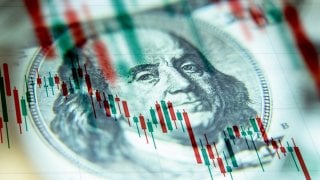The Federal Reserve Ignores the Money Supply at its Peril
The Fed should pay much more attention to the money supply numbers, especially when those numbers swing from a record pace of increase to one of contraction.
Milton Friedman must be rolling in his grave at the thought of how his basic monetary policy teachings have fallen out of favor. Federal Reserve Chair Jerome Powell never so much as mentions the money supply in discussing the U.S. economic and inflation outlook. In pursuing a strictly data-dependent monetary policy, Mr. Powell has forgotten that monetary policy operates with long and variable lags. Meanwhile, a growing chorus of prominent economists claim that inflation, both on the way up and on the way down, was but a transitory phenomenon that had nothing to do with the money supply.
Many years of painstaking monetary policy research across many countries led Friedman to conclude that inflation was always and everywhere a monetary phenomenon. In other words, an economy could not have a sustained burst of inflation without a pronounced increase in the broad money supply. By the same token, he argued that allowing the broad money supply to contract was a surefire recipe for inviting deflation. In his view, the prolonged deflation period in the 1930s directly resulted from the Fed allowing the banks to fail and the money supply to plunge.
Armed with Friedman’s theories, the monetarists accurately predicted the inflation surge to a multi-decade high of 9 percent by June 2022. They had warned that the Fed was playing with inflationary fire when it allowed the broad money supply to increase by a cumulative 40 percent between the start of 2020 and the end of 2021 as its response to the Covid-induced recession. After all, that was by far the fastest rate of money supply increase in the postwar period.
By contrast, much of the economic profession dismissed the monetarists as being out to lunch. Instead, they mistakenly clung to the idea that inflation would not rise by very much on a sustained basis. They claimed that any inflation we saw was related to supply chain disruptions or commodity price increases that would soon dissipate when the pandemic ended.
Fast forward to today, we find a Fed that has slammed on the monetary policy brakes in an unusually aggressive way to regain inflation control. In eighteen months, the Fed has raised interest rates by as much as 5.25 percentage points, something it has not done in decades. At the same time, it has shifted from a policy of aggressively buying Treasury bonds and mortgage-backed securities to one of aggressively selling those assets. The net upshot is that the broad money supply is now contracting significantly. Such a money supply contraction has not occurred in the sixty-five years that the Federal Reserve has published comprehensive money supply data.
The monetarists are now warning that by allowing the broad money supply to contract, the Fed is inviting a meaningful recession next year that will more than slay the inflationary beast. While it is too early to say whether the monetarists will be as correct in predicting the end of inflation as they were in predicting its earlier surge, today’s consumer price numbers seem to lend support to their view. Having peaked at 9 percent last year, headline inflation is now running at 3.25 percent. If the monetarists are right, we will see inflation as yesterday’s problem when we have to cope with a Fed-induced recession next year.
This is not to say that only money supply developments should guide the Fed. However, the Fed should pay much more attention to the money supply numbers, especially when those numbers swing from a record pace of increase to one of contraction. Maybe then the Fed will succeed more than it has been doing of late in meeting its dual mandate of price stability and maximum employment.
American Enterprise Institute senior fellow Desmond Lachman was a deputy director in the International Monetary Fund’s Policy Development and Review Department and the chief emerging-market economic strategist at Salomon Smith Barney.
Image Credit: Shutterstock.


